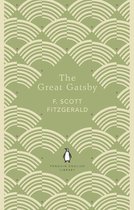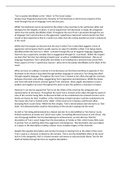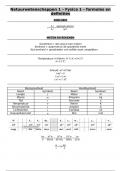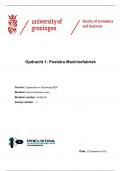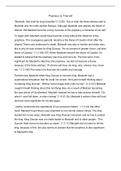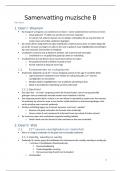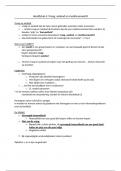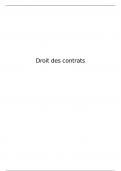‘Tom is quickly identifiable as the “villain” of The Great Gatsby.’
Analyse how Fitzgerald presents the character of Tom Buchanan in the first two chapters of the
novel through the use of language, form and structure.
Whilst Tom Buchanan can be presented as the villain in the novel due to his well known affair and
disregard for the integrity of others, it can be argued that Tom Buchanan is simply the antagonist
rather than the quickly identifiable villain. Throughout the novel Tom is presented through the use
of language, form and structure as the aggressive ‘superlicious mannered’ society typical man that
would’ve been expected to find in a earlier era rather than the roaring twenties era that is embraced
in the novel.
Within the first chapter we discover that the way in which Tom is described suggests a form of
aggression and arrogance that is usually used as an aspect to identify a villain. Tom being clearly
identified within the novel as a ‘villain’, is shown through the use of negative language suggesting
that Tom has a superiority complex that is exaggerated through his ‘cruel body’. Within the chapter
we learn that Tom has ‘two shining arrogant eyes’ as well as ‘established dominance’, this use of
language weaponises Tom’s physicality and makes it an invading force towards those around him.
These aspects of Tom’s ‘superlicious manner’, allow him to be quickly identifiable as the villain of the
novel.
When we focus on setting in contrast to Tom Buchanan we find that everything is opposite of Tom
Buchanan as the house is described through positive language in contrast to Tom being described
through negative language. Throughout the novel Tom is framed as the villain through the contrasts
between characters and setting, exaggerating Tom’s aggression and dominance. Whilst the house
and Toms wife both directly contrast against Toms character, these angelic descriptions create a
positive and negative structure throughout the poem to give the audience a character to blame.
However it can also be argued that Tom is not the villain of the novel but the antagonist and
representative of old money. Throughout the novel Tom is framed as the villain through the point of
view of the narrator being Nick. As discovered Nick can be considered to be a biased narrator as his
family are known for their ‘tradition’ of lies. Nick being a biased narrator could be considered to be
the reason why Tom is framed as the ‘villain’ of the novel as he is having a well known affair,
betraying Nick’s cousin Daisy. Within the first chapter, Tom is dehumanised and referred to as ‘that
body’, this dehumanisation could be the jealousy of the narrator seeping into the novel.
As well as Tom being dehumanised by a biased narrator he is also belittled as Tom had an ‘acute
limited excellence at twenty one’ which now makes ‘everything afterward savour of anti climax’, this
use of language belittles Tom by downplaying his achievements, we also discover that the
description of Tom is much longer than the descriptions of Gatsby or Nick, which leaves little room
to portray Tom as anything other than aggressive and dangerous. This description also uses ellipsis
as a pause in the description creating a slower more complex imagery of the character.
Despite the negative description and narrator focusing on framing Tom as the villain of the novel,
Tom is used as a character to blame by the narrator. Tom is not the identifiable villain of the novel
but he is the antagonist, Nick is a biased narrator and seems to subconsciously blame Tom for the
death of Gatsby through his focus on negative description.
Analyse how Fitzgerald presents the character of Tom Buchanan in the first two chapters of the
novel through the use of language, form and structure.
Whilst Tom Buchanan can be presented as the villain in the novel due to his well known affair and
disregard for the integrity of others, it can be argued that Tom Buchanan is simply the antagonist
rather than the quickly identifiable villain. Throughout the novel Tom is presented through the use
of language, form and structure as the aggressive ‘superlicious mannered’ society typical man that
would’ve been expected to find in a earlier era rather than the roaring twenties era that is embraced
in the novel.
Within the first chapter we discover that the way in which Tom is described suggests a form of
aggression and arrogance that is usually used as an aspect to identify a villain. Tom being clearly
identified within the novel as a ‘villain’, is shown through the use of negative language suggesting
that Tom has a superiority complex that is exaggerated through his ‘cruel body’. Within the chapter
we learn that Tom has ‘two shining arrogant eyes’ as well as ‘established dominance’, this use of
language weaponises Tom’s physicality and makes it an invading force towards those around him.
These aspects of Tom’s ‘superlicious manner’, allow him to be quickly identifiable as the villain of the
novel.
When we focus on setting in contrast to Tom Buchanan we find that everything is opposite of Tom
Buchanan as the house is described through positive language in contrast to Tom being described
through negative language. Throughout the novel Tom is framed as the villain through the contrasts
between characters and setting, exaggerating Tom’s aggression and dominance. Whilst the house
and Toms wife both directly contrast against Toms character, these angelic descriptions create a
positive and negative structure throughout the poem to give the audience a character to blame.
However it can also be argued that Tom is not the villain of the novel but the antagonist and
representative of old money. Throughout the novel Tom is framed as the villain through the point of
view of the narrator being Nick. As discovered Nick can be considered to be a biased narrator as his
family are known for their ‘tradition’ of lies. Nick being a biased narrator could be considered to be
the reason why Tom is framed as the ‘villain’ of the novel as he is having a well known affair,
betraying Nick’s cousin Daisy. Within the first chapter, Tom is dehumanised and referred to as ‘that
body’, this dehumanisation could be the jealousy of the narrator seeping into the novel.
As well as Tom being dehumanised by a biased narrator he is also belittled as Tom had an ‘acute
limited excellence at twenty one’ which now makes ‘everything afterward savour of anti climax’, this
use of language belittles Tom by downplaying his achievements, we also discover that the
description of Tom is much longer than the descriptions of Gatsby or Nick, which leaves little room
to portray Tom as anything other than aggressive and dangerous. This description also uses ellipsis
as a pause in the description creating a slower more complex imagery of the character.
Despite the negative description and narrator focusing on framing Tom as the villain of the novel,
Tom is used as a character to blame by the narrator. Tom is not the identifiable villain of the novel
but he is the antagonist, Nick is a biased narrator and seems to subconsciously blame Tom for the
death of Gatsby through his focus on negative description.

